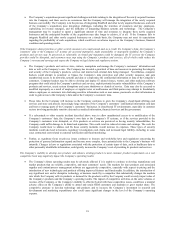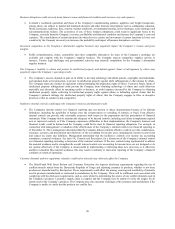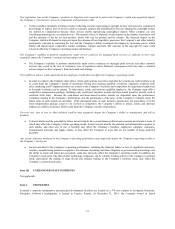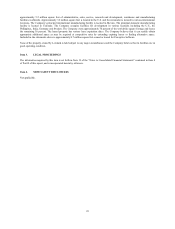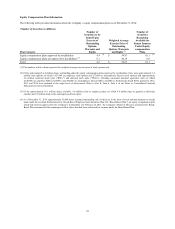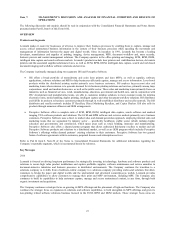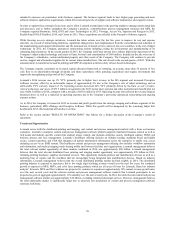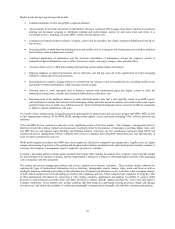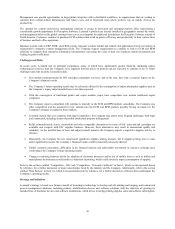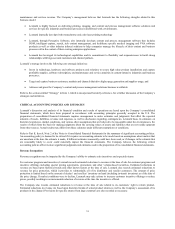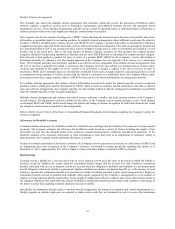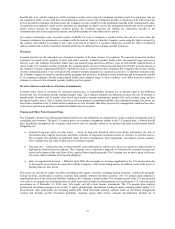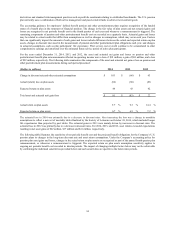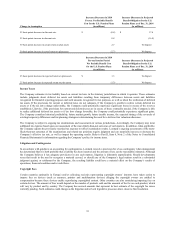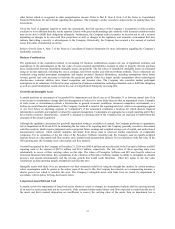Lexmark 2014 Annual Report Download - page 32
Download and view the complete annual report
Please find page 32 of the 2014 Lexmark annual report below. You can navigate through the pages in the report by either clicking on the pages listed below, or by using the keyword search tool below to find specific information within the annual report.intended to increase our penetration in the business segment. The business segment tends to have higher page generating and more
software intensive application requirements, which drive increasing levels of supplies and software maintenance and support revenue.
In order to support these strategic focus areas, and to allow Lexmark to participate in the growing market to manage unstructured data
and processes, and to further strengthen the Company’s products, content/business process management solutions and MPS, the
Company acquired Brainware, Nolij, ISYS and Acuo Technologies in 2012; Twistage, Access Via, Saperion and Pacsgear in 2013;
ReadSoft and GNAX Health in 2014; and Claron in 2015. These acquisitions are included in the Perceptive Software segment.
While focusing on core strategic initiatives, Lexmark has taken actions over the last few years to improve its cost and expense
structure. As a result of restructuring initiatives, significant changes have been implemented, from the consolidation and reduction of
the manufacturing and support infrastructure and the increased use of shared service centers in low-cost countries, to the exit of inkjet
technology. In 2012, the Company announced restructuring actions including exiting the development and manufacturing of its
remaining inkjet hardware. In the second quarter of 2013, the Company and Funai entered into a Master Inkjet Sale Agreement of the
Company’s inkjet-related technology and assets to Funai for total cash consideration of $100 million. Included in the sale were one of
the Company’s subsidiaries, certain intellectual property and other assets of the Company. The Company will continue to provide
service, support and aftermarket supplies for its current inkjet installed base. The sale closed in the second quarter of 2013. With this
announcement, Lexmark has focused its printing and MFP development activities solely in laser-based technologies.
The Company remains committed on its stated capital allocation framework of returning, on average, more than 50 percent of free
cash flow to its shareholders through dividends and share repurchases while pursuing acquisitions and organic investments that
support the strengthening and growth of the Company.
Lexmark’s 2014 revenue was up 1% YTY, primarily due to higher laser revenue in the ISS segment and increased Perceptive
Software revenue, offset by an unfavorable impact of approximately 4% due to the Company’s exit of inkjet technology and an
unfavorable YTY currency impact of 1%. Operating income decreased 64% YTY primarily driven by the Gain on sale of inkjet-
related technology and assets of $73.5 million recognized in the 2013 period and a pension and other postretirement benefit plan net
loss of $80.5 million in 2014, compared with a net gain of $83.0 million in 2013. Operating income also reflected the revenue impacts
discussed above as well as a reduction in operating expenses due to the Company’s previously announced restructuring and ongoing
expense actions.
As in 2014, the Company is focused in 2015 on revenue and profit growth from the strategic imaging and software segments of the
business, particularly MPS offerings and Perceptive Software. While this growth will be dampened by the remaining Inkjet Exit
headwind in 2015, this headwind will decline over time.
Refer to the section entitled “RESULTS OF OPERATIONS” that follows for a further discussion of the Company’s results of
operations.
Trends and Opportunities
Lexmark serves both the distributed printing and imaging, and content and process management markets with a focus on business
customers. Lexmark’s enterprise content and process management software platform supports traditional business content as well as
rich media and industry-specific content like medical image content, and includes enterprise search, intelligent capture, DOM, and
business process and case management. Lexmark’s healthcare offering includes an industry leading, standards based and highly
secure, content repository and VNA that integrates all patient unstructured information across the enterprise to enable easy access
including access via an EMR system. This healthcare content and process management offering also includes workflow automation
and information and medical imaging study sharing within and between facilities and organizations. Lexmark management believes
the total relevant market opportunity of these markets combined in 2014 was approximately $80 billion. Lexmark management
believes that the total relevant distributed laser printing and imaging market opportunity was approximately $70 billion in 2014,
including printing hardware, supplies and related services. This opportunity includes printers and multifunction devices as well as a
declining base of copiers and fax machines that are increasingly being integrated into multifunction devices. Based on industry
information, Lexmark management believes that the overall distributed printing market declined slightly in 2014. The distributed
printing industry is expected to experience flat to low single digit declining revenue overall over the next few years, but continued
growth is expected in MPS, MFPs, and color laser printing products which are all areas of focus for Lexmark. Based on industry
analysts’ forecasts, MPS and fleet solutions are projected to continue to experience approximately 10% annual revenue growth rates
over the next several years and the relevant content and process management software markets that Lexmark participates in are
projected to grow in aggregate approximately 11% annually over the next several years. In 2014, the total relevant content and process
management software market was approximately $10 billion, excluding related professional services. However, management believes
the total addressable market is significantly larger due to relatively low penetration of content and process management software
solutions worldwide.
28


